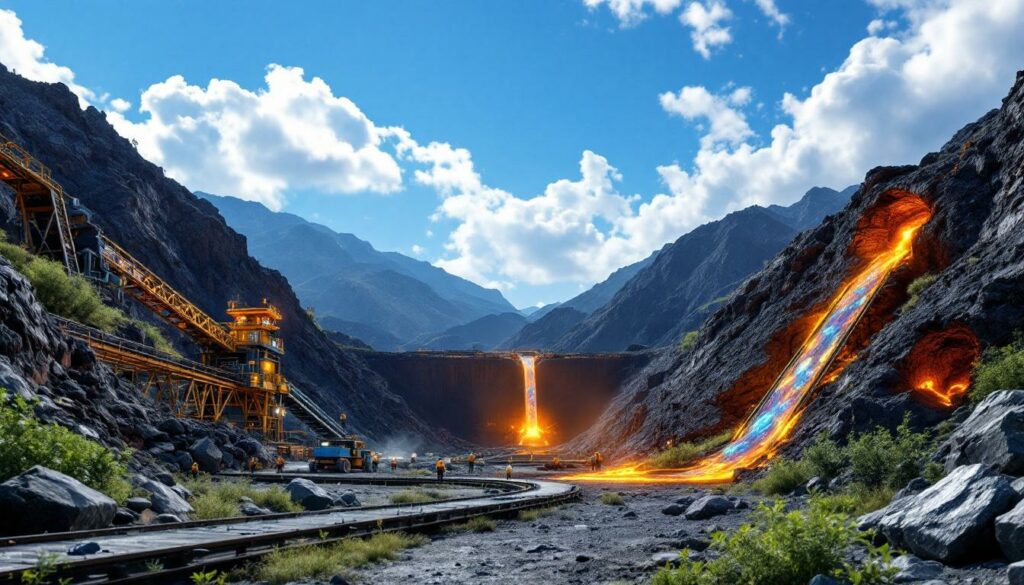What is the Hurricane Creek Mining Project?
The Hurricane Creek Mining Project represents a significant development in the US coal industry. Recently approved by the Department of Interior, this ambitious coal mining operation is set to become a cornerstone of domestic coal production in Tennessee. Situated on Bryson Mountain in Claiborne County, the project encompasses approximately 635 acres of resource-rich land positioned strategically for efficient extraction and transportation.
Hurricane Creek Mining, LLC will implement various mining techniques including auger, highwall, and contour methods to access multiple coal seams within the approved area. These diverse extraction methods have been selected to maximize yield while adhering to the expedited environmental requirements established under recent policy changes related to mining industry evolution.
"This project reflects a broader shift, one where American resources are being put to work for American strength," stated Adam Suess, Acting Assistant Secretary for Land and Minerals Management. "We're not just issuing permits – we're supporting communities, securing supply chains for critical industries, and making sure the US stays competitive in a changing global energy landscape."
Project Overview and Location
The Hurricane Creek Mining Project is strategically positioned in the Appalachian coal basin region of eastern Tennessee. Claiborne County has historically been a coal-producing area, with its unique geology providing access to high-quality coal seams that have been valued for both thermal and metallurgical applications.
The 635-acre operation will utilize a combination of surface mining techniques, specifically designed to access the varied coal deposits present across Bryson Mountain's terrain. The project's location provides significant logistical advantages with established transportation infrastructure nearby, allowing for efficient movement of extracted resources to market despite ongoing coal supply challenges in the industry.
Geological Note: The Cumberland Plateau coal deposits in Tennessee are known for their high carbon content and relatively low sulfur levels compared to many other US coal regions, making them particularly valuable for metallurgical applications.
Production Capacity and Timeline
Hurricane Creek Mining is projected to extract up to 1.8 million tons of coal annually once fully operational. With a planned 10-year operational timeline, the total production could reach 18 million tons, representing a significant contribution to domestic coal supply.
The operation will focus on two primary coal types:
- Specialty market coal – Higher-grade coal suitable for steelmaking and specialized industrial applications
- Thermal use coal – Suitable for electricity generation, often blended with other coal types
One particularly noteworthy aspect of the Hurricane Creek project is the potential for rare earth elements (REEs) and trace minerals extraction. Recent geological surveys have identified promising concentrations of these critical materials within certain coal seams on the property.
Table: Hurricane Creek Mining Project Key Facts
| Project Aspect | Details |
|---|---|
| Location | Bryson Mountain, Claiborne County, Tennessee |
| Total Area | 635 acres |
| Annual Production | Up to 1.8 million tons |
| Operational Timeline | 10 years |
| Mining Methods | Auger, highwall, and contour techniques |
| Primary Applications | Steelmaking, industrial use, power generation |
| Secondary Potential | Rare earth elements and trace minerals |
How Does This Approval Align With Current Energy Policy?
The approval of the Hurricane Creek Mining Project represents a tangible manifestation of recent shifts in US energy policy. Following the national energy emergency declaration by President Trump in early 2025, regulatory frameworks governing resource extraction have undergone significant transformation, with coal regaining prominence in the national energy strategy.
This permit approval was facilitated through an expedited environmental review process, established under newly implemented procedures designed to accelerate domestic energy production. The streamlined approach prioritizes energy security while maintaining basic environmental safeguards, reflecting the administration's commitment to balancing resource development with responsible stewardship.
Recent Policy Changes
Executive Order 14261, titled "Reinvigorating America's Beautiful Clean Coal Industry," established the policy foundation for Hurricane Creek's approval. This US production executive order directed federal agencies to prioritize domestic coal production as part of a broader energy independence strategy, identifying coal as a critical resource for both power generation and industrial applications.
The policy shift extends beyond executive action to include legislative support through the recently passed One Big Beautiful Bill Act. This comprehensive legislation contains multiple provisions designed to reinvigorate the coal industry, including:
- Significant reductions in royalty rates for mining on federal lands
- Opening millions of previously restricted acres for federal coal leasing
- Streamlined permitting processes with defined decision timelines
- Modified environmental review requirements focusing on economic benefits
- Financial incentives for advanced coal technologies and rare earth element extraction
Policy Context: The Hurricane Creek approval represents the first major coal project authorized under these new expedited procedures, potentially establishing precedent for future developments.
Regulatory Framework Changes
The regulatory landscape governing coal extraction has been fundamentally restructured, with several key changes directly impacting the Hurricane Creek project:
- Environmental review acceleration – Shortened timelines for impact assessments with emphasis on economic benefits
- Permitting streamlining – Consolidated application processes across multiple agencies
- Royalty rate reductions – Decreased federal royalty rates from 12.5% to 8% for surface mining
- Land access expansion – Reopening previously restricted federal lands for leasing
- Critical mineral prioritization – Expedited approvals for projects with rare earth element potential
This regulatory transformation represents a deliberate shift from the previous administration's more restrictive approach to fossil fuel development. Under the current framework, energy production and economic development receive greater weight in regulatory decisions, though basic environmental protections remain in place.
Table: Policy Changes Impacting Hurricane Creek Approval
| Policy Action | Key Provisions | Impact on Project |
|---|---|---|
| National Energy Emergency Declaration | Authorized expedited approvals for domestic energy projects | Accelerated permit timeline |
| Executive Order 14261 | Prioritized coal industry revitalization and directed agencies to streamline approvals | Established policy framework for approval |
| One Big Beautiful Bill Act | Reduced royalty rates, opened federal lands, streamlined permitting | Created favorable economic conditions |
| Expedited Environmental Review | Modified assessment requirements with emphasis on economic benefits | Facilitated faster approval with modified conditions |
What Economic Benefits Are Expected?
The Hurricane Creek Mining Project is projected to deliver substantial economic benefits to Claiborne County and the broader Tennessee region. As one of the largest industrial developments in the area in recent years, the project promises to create both direct mining positions and indirect support industry jobs throughout the operational period.
While specific job numbers haven't been officially released, industry analysts estimate that mining operations of this scale typically generate 200-300 direct positions, with an additional 400-600 indirect jobs in supporting industries and services. These employment opportunities will provide significant income streams in a region that has experienced economic challenges following the decline of coal mining in previous decades.
Job Creation and Local Economy
The mining operation will create diverse employment opportunities across multiple skill levels, from equipment operators and mechanics to engineers and management personnel. Many of these positions offer competitive wages significantly above the county's median income, providing pathways to middle-class stability for local families.
Key economic benefits include:
- Direct mining positions – Equipment operators, mechanics, electricians, blasters, safety personnel
- Support industry employment – Transportation, equipment supply, maintenance services
- Professional services – Engineering, environmental monitoring, administrative
- Local business stimulation – Retail, hospitality, housing, and service sectors
The economic impact extends beyond direct employment. Local businesses from restaurants to equipment suppliers typically experience increased demand during both construction and operational phases. Additionally, the project will generate substantial tax revenue for Claiborne County, potentially funding improvements to schools, infrastructure, and public services.
Economic Context: Claiborne County's unemployment rate has consistently remained 2-3 percentage points above the national average over the past decade, making job creation initiatives particularly valuable for community stability.
Industrial Supply Chain Impacts
Beyond local economic effects, the Hurricane Creek project strengthens critical domestic supply chains. The high-quality metallurgical coal from the operation will directly support American steel manufacturing, reducing dependence on imported resources and enhancing industrial self-sufficiency.
The project's impact on industrial supply chains includes:
- Steel manufacturing support – Providing essential metallurgical coal for domestic steel production
- Power generation reliability – Contributing thermal coal to regional electricity production
- Rare earth element potential – Possible extraction of critical minerals and energy security used in high-tech applications
- Transportation network utilization – Increased rail and truck transportation demand
- Equipment manufacturing demand – Purchases of domestically produced mining equipment
This strengthening of industrial supply chains carries national significance, particularly for steel production. Metallurgical coal from operations like Hurricane Creek enables domestic steel manufacturers to reduce reliance on foreign coal sources, enhancing price stability and supply security for critical infrastructure projects.
Table: Economic Impact Categories
| Impact Category | Primary Benefits | Secondary Benefits |
|---|---|---|
| Direct Employment | Mining positions at competitive wages | Skills development and career advancement |
| Indirect Employment | Support industry jobs and services | Broader economic diversification |
| Tax Revenue | County and state income from operations | Improved public services and infrastructure |
| Industrial Supply | Domestic steel manufacturing support | Reduced import dependence and price stability |
| Community Development | Population stability and growth | Enhanced retail and service options |
What Are the Environmental Considerations?
The Hurricane Creek Mining Project incorporates various environmental considerations balanced against energy production goals. Operating under the expedited review procedures established in 2025, the project must still adhere to basic environmental standards while benefiting from streamlined approval processes.
Surface mining across the 635-acre site will utilize multiple extraction techniques, each with specific environmental implications. The permit requires comprehensive land reclamation plans to restore the area after mining operations conclude, though with modified standards compared to previous regulatory frameworks.
Mining Methods and Land Use
The Hurricane Creek operation will employ three primary mining methods across the Bryson Mountain site:
- Contour mining – Following coal seams along hillsides, creating a series of benches
- Highwall mining – Using specialized equipment to extract coal from exposed seam faces
- Auger mining – Drilling horizontally into coal seams from the highwall face
Each method presents unique environmental challenges and considerations:
- Topographical changes – Surface mining necessarily alters landforms during extraction
- Soil and rock management – Requires proper handling and storage of overburden materials
- Water management systems – Controls for surface water runoff and sediment containment
- Habitat considerations – Temporary displacement of wildlife with phased restoration
- Dust and noise controls – Mitigation measures for nearby communities
The permit requires a comprehensive land reclamation strategy that will be implemented progressively throughout the mining operation. Post-mining land use plans include a combination of reforestation, wildlife habitat creation, and potential recreational areas, with mine reclamation innovation techniques being applied to improve restoration outcomes.
Environmental Context: The Cumberland Plateau region has experienced extensive surface mining historically, with varying degrees of successful reclamation. Modern techniques offer improved restoration potential compared to earlier mining practices.
Environmental Review Process
Under the expedited review procedures established in 2025, the Hurricane Creek project underwent a modified environmental assessment process. While accelerated compared to previous frameworks, the review still evaluated key environmental factors:
Water Resources
- Watershed protection measures for nearby streams
- Sediment control systems and monitoring requirements
- Groundwater impact assessment and mitigation
Biodiversity Considerations
- Wildlife surveys with focus on protected species
- Habitat management and restoration planning
- Temporary impact mitigation strategies
Air Quality Management
- Dust suppression requirements
- Equipment emission standards
- Monitoring protocols during operations
Reclamation Requirements
- Soil conservation and replacement specifications
- Revegetation with native species
- Landform restoration parameters
- Post-mining drainage systems
The permit includes ongoing monitoring requirements throughout the operational period, with regular reporting to regulatory authorities. Compliance verification will occur through a combination of self-reporting and periodic site inspections, though with reduced frequency compared to previous regulatory frameworks.
Table: Environmental Aspects and Mitigation Measures
| Environmental Aspect | Potential Impact | Required Mitigation |
|---|---|---|
| Land Disturbance | Topographical changes and habitat disruption | Phased mining with progressive reclamation |
| Water Resources | Sediment runoff and drainage alterations | Containment systems and monitoring requirements |
| Air Quality | Dust generation and equipment emissions | Suppression techniques and equipment standards |
| Wildlife | Habitat displacement | Phased operations and habitat restoration |
| Noise | Operational sounds affecting nearby areas | Time restrictions and equipment modifications |
How Does This Project Impact US Energy Independence?
The Hurricane Creek Mining Project represents a significant contribution to America's energy independence strategy. With production capacity of up to 1.8 million tons annually, the operation strengthens domestic resource availability for both power generation and critical industrial applications like steelmaking.
This project aligns with broader national objectives to reduce dependence on imported energy resources, particularly specialized coal types that support strategic industries. By expanding domestic production capacity, Hurricane Creek enhances supply security and provides insulation against international market volatility.
Domestic Energy Resource Development
The approval of Hurricane Creek reflects a deliberate policy shift toward prioritizing domestic energy resource development. By authorizing this significant coal mining operation, the Department of Interior is pursuing several strategic objectives:
- Resource diversification – Maintaining coal as part of a balanced energy portfolio
- Supply chain security – Ensuring reliable domestic sources for critical industries
- Import reduction – Decreasing reliance on foreign coal supplies
- Energy resilience – Strengthening against international market disruptions
- Industrial support – Providing essential resources for manufacturing and power generation
The project's contribution to energy independence extends beyond simple production volume. The high-quality metallurgical coal from Hurricane Creek specifically addresses a critical industrial input that has increasingly relied on imports in recent decades.
Supply Context: U.S. metallurgical coal imports have grown significantly over the past decade, with Australia and Canada serving as primary suppliers. Hurricane Creek's production directly offsets this import dependence.
Market Positioning and Competition
Hurricane Creek's output will strengthen America's position in both domestic and global coal markets. The particular characteristics of Tennessee coal—with its favorable carbon content and relatively low sulfur levels—provide competitive advantages for specialized applications:
- Metallurgical quality – Premium characteristics for steel production
- Industrial suitability – Properties valued for specialized industrial processes
- Blending potential – Compatibility with other coal types for optimal outcomes
- Geographic advantage – Proximity to domestic steel producers and export facilities
The economic implications extend beyond the mining operation itself. By providing a stable domestic supply of critical coal resources, Hurricane Creek helps insulate American manufacturers from international price volatility and supply disruptions. According to a recent report on the fast-track approval process, this project represents a significant step in prioritizing domestic energy resources.
Table: Energy Independence Contributions
| Contribution Area | Impact Mechanism | Strategic Value |
|---|---|---|
| Resource Availability | 1.8 million tons annual production | Reduced import dependence |
| Industrial Support | High-quality metallurgical coal | Strengthened steel manufacturing |
| Supply Stability | Domestic production with reliable delivery | Protection from international disruptions |
| Price Predictability | Consistent local supply without shipping variability | Enhanced planning for industrial consumers |
| Export Potential | High-quality product with international demand | Improved trade balance possibilities |
What Are the Specialty Applications of This Coal?
The Hurricane Creek Mining Project will produce coal with exceptional characteristics that make it particularly valuable for specialized applications. Beyond conventional power generation, this Tennessee coal possesses properties that create significant demand in metallurgical processes and other industrial applications requiring high-carbon, low-impurity fuel sources.
The project's most economically significant output will be metallurgical grade coal, essential for steel production and commanding premium market prices. Additionally, geological assessments suggest promising concentrations of rare earth elements and other critical minerals within certain coal seams, potentially creating valuable secondary recovery opportunities.
Steel Manufacturing Applications
Metallurgical coal (often called "met coal" or "coking coal") serves as a primary ingredient in steel production, where it is converted to coke for use in blast furnaces. The Hurricane Creek coal possesses several characteristics that make it particularly suitable for this critical application:
- High carbon content – Typically 85-89% fixed carbon
- Low sulfur levels – Often below 1%, reducing impurities
- Strong coking properties – Forms solid coke when heated
- Appropriate volatile matter – Usually 20-25%, ideal for coking
- Low ash content – Minimizing waste and impurities
These properties make Hurricane Creek's metallurgical coal particularly valuable to domestic steel manufacturers. As steel production requires specific coal qualities that cannot be substituted with thermal coal, metallurgical grades command significantly higher market prices and face less competition from alternative energy sources.
Industry Context: American steel production relies heavily on high-quality metallurgical coal. While the U.S. has abundant thermal coal reserves, metallurgical coal with ideal properties is less common, making Hurricane Creek's output strategically valuable.
Rare Earth Elements and Critical Minerals
One of the most promising aspects of the Hurricane Creek project is the potential for rare earth element (REE) and critical mineral recovery. Geological assessments have identified notable concent
Ready to Stay Ahead of Major Mineral Discoveries?
Discover significant ASX mineral discoveries as they happen with Discovery Alert's proprietary Discovery IQ model, turning complex market data into actionable investment insights. Explore why major mineral discoveries can lead to exceptional returns by visiting Discovery Alert's dedicated discoveries page and begin your 30-day free trial today.




